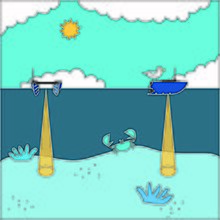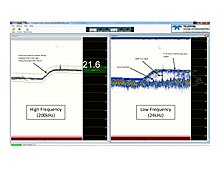Echo sounding
Hydroacoustic assessments have traditionally employed mobile surveys from boats to evaluate fish biomass and spatial distributions.Though a fully operational échosondeur (sonar) was not ready for use in wartime, there were successful trials both off Toulon and in the English Channel as early as 1920, and French patents taken for civilian uses.Oceanographic ships and French high-sea fishing assistance vessels were equipped with Langevin-Florisson and Langevin Marti recording sonars as early as the mid/late 1920s.[5] Distance is measured by multiplying half the time from the signal's outgoing pulse to its return by the speed of sound in water, which is approximately 1.5 kilometres per second.For high accuracy depths, usually restricted to special purpose or scientific surveys, a sensor may be lowered to measure the temperature, pressure and salinity.As well as an aid to navigation (most larger vessels will have at least a simple depth sounder), echo sounding is commonly used for fishing.Therefore, it is especially important when sounding in deep water, as the resulting footprint of the acoustic pulse can be very large once it reaches a distant sea floor.In order to meet these standards, the surveyor must consider not only the vertical and horizontal accuracy of the echo sounder and transducer, but the survey system as a whole.






echographymultibeam echosounderrangingbathymetrytime of flightspeed of soundchartingfish schoolssoundingsounding lineAlexander BehmpatentPaul LangevinMarie Curienuclear physicsFrench Navypiezoelectric transmitterToulonEnglish ChannelFessenden oscillatorSound speed profilehydrographysound velocity probefathomfishfindermap the seabedacoustic wavestransceiverecho soundersbeamformingswathedepth soundingsfishingfrequencytransducerTeledyneresolutionInternational Hydrographic Organizationuncertainty budgetAcoustical oceanographyBathymeterDepth gaugeFisheries acousticsHydroacousticsHydrographic surveyDepth soundingUnderwater acousticsJohn Wiley & SonsSpringer PublishingWayback MachineActive acousticsBaffles (submarine)Bistatic sonarGLORIA sidescan sonarPassive acousticsScientific echosounderSide-scan sonarSonobuoySurveillance Towed Array Sensor SystemSynthetic aperture sonarTowed array sonarUpward looking sonarOcean acousticsAcoustic networkAcoustic releaseAcoustic Doppler current profilerAcoustic seabed classificationHydrophoneLong baseline acoustic positioning systemOcean acoustic tomographyShort baseline acoustic positioning systemSofar bombSOFAR channelSound speed gradientUltra-short baseline acoustic positioning systemUnderwater acoustic communicationUnderwater acoustic positioning systemAcoustic ecologyAcoustic survey in fishingAcoustic tagAnimal echolocationBeached whaleDeep scattering layerMarine mammals and sonarWhale songAcoustic signatureBioacousticsBiophonyGeophysical MASINTNoise mapSoundscapePhysical oceanographyAiry wave theoryBallantine scaleBenjamin–Feir instabilityBoussinesq approximationBreaking waveClapotisCnoidal waveCross seaDispersionEdge waveEquatorial wavesGravity waveGreen's lawInfragravity waveInternal waveIribarren numberKelvin waveKinematic waveLongshore driftLuke's variational principleMild-slope equationRadiation stressRogue waveDraupner waveRossby waveRossby-gravity wavesSea stateSeicheSignificant wave heightSolitonStokes driftStokes problemStokes waveTrochoidal wave